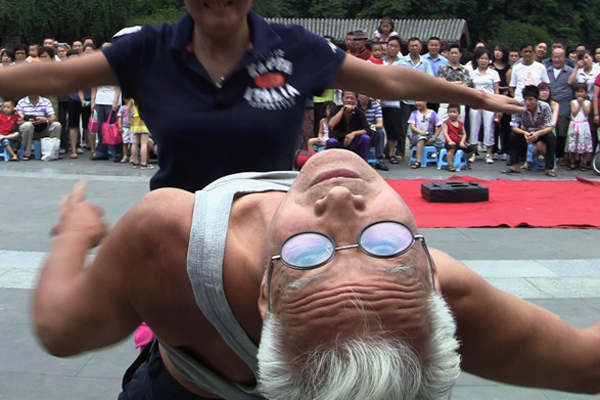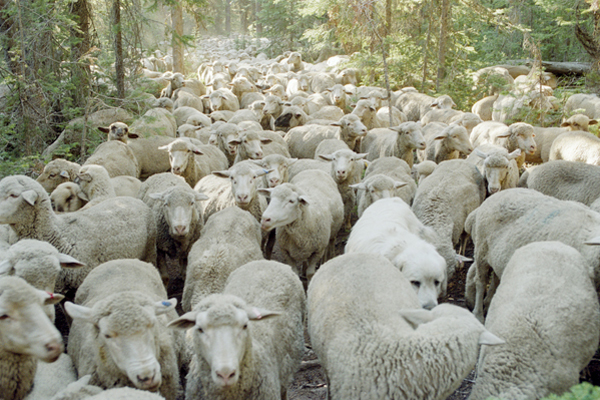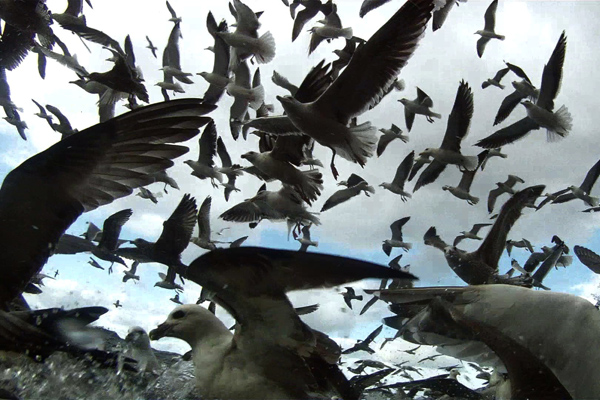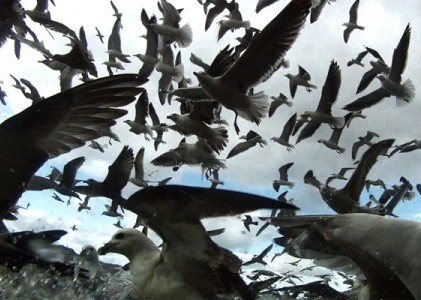Signal to Noise
"We've never found anyone who really devotes himself to recording sound," Richard Leacock complained many years ago. "At the moment it's not a technical problem, it's a human problem. You have to think of sound and image as two cameras with two quite different problems." Of course the familiar picture of the boom operator trailing the vérité cameraman itself betrays a certain anxiety about isolating the "right" sounds, but the majority of American documentaries simply sidestep the problem by recording audio in a soundproofed environment. The films from Harvard's Sensory Ethnography Lab take a different route, risking sonic chaos to bring us to our senses. Ilisa Barbash and Lucien Castaing-Taylor's Sweetgrass (2009), Véréna Paravel and J.P. Sniadecki's Foreign Parts (2010), Libbie Cohn and Sniadecki's People's Park (2012) and Castaing-Taylor and Paravel's Leviathan (2012) engage very different environmental and social conditions, but they're unified in their phenomenological faith in reality. This aesthetic attitude takes definite form in the sculptural approach to location sound. As the lab's manager and sound editor and mixer for all of the films mentioned above, Ernst Karel is by any measure a critical part of the equation.

People's Park
Sound is channeled rather than framed: this basic fact is fundamental to SEL's underlying goal of anthropology by other means—in a word, embodiment. Before Sweetgrass is about the American pastoral on its last legs, it is the sound of sheep and shears and men muttering to themselves. Before Foreign Parts is about eminent domain and a neighborhood's complex network of relations, it is the multidirectional soundscape of shouting, heavy machinery, the elevated subway, planes overhead, and the different sounds of the pocked road depending on the season. Before People's Park is about the interpolations of leisure and restiveness in China's public spaces, it is about the way sound ropes off invisible boundaries in the titular park. As for Leviathan (which opens in New York on March 1), let us simply say that the keening soundtrack is the ocean upon which the images bob, pitch, and drown. The film's extraordinary power as a work of expanded cinema—to say nothing of its sublime apprehension of a reality stretching the limits of human consciousness—flows from the soundtrack's gasping, clanging, groaning unrest.
Karel's Cage-an understanding of contingency and experience as paths of creation naturally complements the SEL filmmakers' experimental recording strategies. His layered mixing suggests an ear open to multiple points of interest and alive to the ever-present possibility of musique concrète. The tangibility of the soundtracks isn't so much the product of delineating discrete signals as capturing the complex ways in which sounds interact with a particular environment and particular microphones. Thoreau was after this same phenomenon when he extolled echo as "an original sound . . . not merely a repetition of what was worth repeating in the bell, but partly the voice of the wood." The SEL films may not be so indrawn, but their fascination with sound as a medium for space and social relations affords a comparable degree of intimacy.
Karel's activities extend far beyond his work on the SEL films. He is currently in post-production on the second installment of Hourly Directional Sound Recordings, a chance-determined quadraphonic installation created in collaboration with the artist Helen Mirra. His own audio-only projects include Swiss Mountain Transport System, a composition compiling location recordings of gondolas and funiculars, and Materials Recover System, a sonic exploration of a recycling plant in Charlestown, Massachusetts. Karel returned to this same space to record sound for Single Stream, a large-scale video installation project done in collaboration with Pawel Wojtasik and Toby Lee that will be featured in the lobby of the Museum of the Moving Image this spring. He was kind enough to break from setting up SEL's postproduction facilities to speak with me about his work in film.
How did you first come to Harvard's Sensory Ethnography Lab and begin working with filmmakers?
My background was in music, both in terms of what you would normally call music and also what you might call noise. I went to graduate school hoping to study cognitive anthropology or linguistic anthropology. I started thinking of signification in terms of language and its relation to thought, but before long I was thinking about the ways that non-linguistic sound does and does not signify because of my interest in music and sound. That led to me doing field work in India. One project involved looking at the way bell sounds function in the context of Hindu ritual in a particular temple in Tamilnadu. From there, I looked at the different roles of amplified sound in public city spaces—how they carve up social spaces and the connections between those amplified sounds and other sonic practices going on in the culture. I was making recordings, but at that time I thought of them primarily as illustrations for my academic writing. This dual background ultimately led me to the Sensory Ethnography Lab. Lucien [Castaing-Taylor] in particular was of the mind that it would be useful to have someone who thinks of sound first rather than image, in terms of training and helping people to be aware of that aspect of the work. I could bring this to bear, that sound should be one of the first things people think about before going out to record. Because that's really when you need to think about it—not afterwards.
Your work on the films coming out of the SEL is primarily in post-production mixing and editing, right?
Yes. For people who have been here for a while, perhaps I've also helped them to think about recording before they go out on a project. But I haven't actually gone and recorded sound with any of them.
What are some differences between your own recording project, where you're intimately familiar with the site, and the film projects where you're dealing with recordings from a place you haven't been?
It's an advantage, in a way, because you don't have your preconceptions about what it should sound like or what you think it sounds like. Your only reference point is what's actually coming through the speakers, so you're not adding your mental image of what was there. With that said, a lot of the [film] projects are done with sync sound, so you do at least see where it was recorded.

Sweetgrass
Something that sets the SEL films apart from most documentaries is the way the sound is allowed to exceed the image. Can you speak a little more about how you actually go about processing the sounds captured for the films? Are you working alone or constantly going back and forth with the filmmakers?
Mostly it is a lot of back and forth. I was really surprised when people writing about Sweetgrass would comment on the sound as being somehow remarkable. To me, it was as straightforward a way of dealing with sound as I could imagine. We weren't doing anything tricky. There are no effects. A lot of it is sync sound, but I think it is something like what you just said, where the sound is allowed to intrude upon what's going on more than might otherwise be the case. For a lot of documentaries, the sound is reined in. It's especially exaggerated when you have a voiceover. Whenever that voice comes in, the sound mysteriously vanishes or gets shifted way down. Sound becomes an optional component of the image when it can suddenly come down for no reason other than someone wants to talk over it.
The world itself is diminished.
In a way, yes. And that's obviously a different approach to moviemaking. But with Sweetgrass, there is plenty of voice and talking, and the way that's dealt with is essentially artificial. The voices are closely recorded with lavalier microphones, and there are conscious decisions about how deeply to enmesh those voices in the landscape or whether to let them come to the forefront. To a large extent, the idea was that there are a lot of animals on screen: some are humans and some are non-humans, so let's put them all together in the mix. You can't understand what a lot of the voices are saying.
Whereas most documentaries privilege intelligibility to the point of redundancy.
We could have easily made the voices intelligible. I could have put them right in the front [of the mix] even though the guy on the horse is 200 meters away. That does happen in the movie when there's that very long shot and he's cursing at all of the sheep.
In that case, it's almost uncanny to be hearing so close and seeing so far.
But then there are other times when the guy is on the horse, and we hardly understand him at all. The sound is buried in the mix, but we had it just as clearly.
Even if we could hear him perfectly, it's not as if he's speaking to the camera and saying, "This is what I mean when I say this or that." And this becomes so much more extreme in Leviathan. In the beginning the voices of the men working the boat sound like they're coming through a broken walkie-talkie.
Well yes, that was a compromised situation. There are a couple of shots where what we're seeing was recorded with good microphones. That opening shot, at least as far as what ended up in the movie, was recorded with the helmet-mounted cameras and their little built-in microphones. The cameras are in a waterproof enclosure, so you have this little mono microphone encased in plastic that records crunchy-sounding low bit rate audio. We had to filter those pretty dramatically so they didn't hurt your ears [laughs]. You can sort of still understand what people are saying, but it ends up sounding like it's coming through a few different layers, which it is. The way that sounds came through on those little GoPro microphones was incredibly unpredictable.
One of the interesting things about the film is the way it frames recording technology as allowing us access to places we couldn't otherwise go but at the same time confronting us with radical limitations of perception.
It wasn't only limitations: the technology also gave gifts. For instance, there were these weird resonances that would come through on these microphones. They're not a faithful representation of, say, the engine sound, but somehow—and I don't know exactly how this was happening—between the engine sounds, the camera enclosure, and the microphone itself, these weird resonances would emerge that seemed motivated by all of the above but not the direct result of any one of those things. We would exaggerate some of these emergent tones tones by using a filter to exaggerate a little peak frequency. There were a couple of shots where there would be a couple of frequencies that would be happening, and so I would exaggerate a different frequency in each channel to create an unsettled feeling.
Did the fact that many of these sounds emerged from the unpredictable interaction of technology and environment, without the same degree of intentionality on the part of the filmmakers, change the nature of the collaboration?
Lucien and Véréna [Paravel] did a huge amount of work on the sound while they were editing the video. A big part of what I did was going through their other recordings. There were a lot of sources for sounds based on other footage that wasn't being used, as well as sound recordings they made just walking around the boat with microphones. Even with the GoPro shots, there are a lot of sounds from those other recordings. It was a matter of going through and finding similar kinds of processes, whether it's cutting the fish or the chains clanging or the nets being hauled up.
Working on these films, do you think of yourself as occupying an intermediary position between the filmmakers and audience? Are you conceiving of a listener differently than you would for a sound-only piece?
With something destined for the cinema, you know that the conditions in which people will be hearing the piece are relatively predictable. When you're composing a sound piece that's going to end up on a CD, people will be listening in unpredictable conditions. I hadn't really thought of the films in the way that you put it, in terms of whether I'm looking out for the audience or the makers. In the case of Leviathan, one thing that was going on with the piece was that they had a very intense and pretty unpleasant time on the boat. So in part we were trying to create an intense and unpleasant experience in the theater. I'm not sure for whose benefit that is.
It's just integral to what it is.
Usually you're not trying to make it unpleasant, and we weren't really trying to make it unpleasant, but then again I've done a lot of stuff in my own sound work that's loud and harsh and intense. That feeling of being disrupted or disturbed from your normal life can be a useful one.

Leviathan
It reminds of the distinction that R. Murray Schafer makes between high-fidelity landscapes and low-fidelity landscapes, which in turn reflects some of the dualities of rural and urban, nature and machine that Leviathan just explodes. Schafer's argument rests on the idea of a clear signal: you're able to pick out the thing you're supposed to be listening for in the high-fidelity landscape. The distinction between signal and noise isn't so clear in the Sensory Ethnography Lab films.
And the boat would be a pretty hellish environment for Schafer for those reasons. He would want to hear the seagulls when the camera comes above the water, but they're being completely drowned out by the ship's engine.
Even in something like Foreign Parts, there are so many different potential points of aural interest, almost like the equivalent of deep focus in photography.
Yeah, and when you ask yourself, "What is the subject here?" it's not so easy. Maybe that's the virtue of a lo-fi environment: there isn't a clear signal to pick out against everything else that's background. Everything is foreground. Everything is worthy of your attention, and it's jostling to get your attention. It's interesting when you can do something like deep focus with sound, but it can easily get messy. One thing that people who are just starting location recording find out when they bring their recordings home is that there are always more sounds than you remembered. You're listening for that one sound that you thought you were recording, and it turns out that there are a million other sounds going on. I think the conventional strategy for mixing for picture is to artificially create a foreground/background situation with sound. Obviously, dialogue is the main example of that. But if you allow there to be multiple competing foregrounds, it shifts the burden onto the viewer or listener to find their own way.
But as you say, at a certain point it's just a mess. Where is that line?
With Leviathan in particular it gets messy because they're not all high-resolution sounds. We were working with these fuzzy, distorted sounds, but at the same time they're also very detailed. That distortion is a very detailed distortion on that frequency response of those microphones, so you can work with that. It's not realism anymore, but you still have high-resolution sounds even though they're sounds of distortion.
Is there any new technology for recording sound that's especially exciting to you?
Not really. You know, sound recording technology doesn't really change that much. In a way things took a step backwards in the last year or two when people started shooting with DSLR cameras to record video with them because those don't record sound well. When people think more and more about sound before going out to shoot, it allows for more possibilities to do more interesting things with 5.1 or surround sound, and that's always fun because it expands the space of viewing more than the sound is just coming from the front of the room.
Like with People's Park?
Yes, that was interesting. It's shot in about the most straightforward way possible—just the single shot? Just the single shot: you turn on the camera, move around, and press stop. All the sound was sync with the addition of a couple cricket sounds here and there. When I first started talking with [J.P Sniadecki and Libbie Dina Cohn] about the sound, I thought that it would be simple stereo sound, a very pure, straightforward kind of approach. They recorded with three microphones. One was a shotgun mic facing forward, and the other two were DSM microphones, which are these pseudo-binaural microphones that are worn on the side of the head. I have a 5.1 studio, so when I started listening to what they recorded I put the center mic in the center channel and the DSM mics left and right. Then I pulled the DSM mics back so that they were coming halfway between the front and the rear, and suddenly the whole space opened way up. Sounds that were not visible onscreen began to sound like they were coming from behind. Your brain is doing a lot of this work. If you're not seeing anything onscreen for a sound, your brain assigns it a place in that space. So suddenly sounds were moving from front to back and vice versa even though it was only the two microphones. That was a revelation, especially combined with that particular image and that particular way of moving through the space. It became clear that the film had to be a 5.1 soundtrack.
The sound is especially tangible in that case, and it also has a distinct life from the image. I was struck by how often it persists beyond what we can see.
Very much so. You're hearing stuff from the distance, and then you're finally getting closer to it. And sometimes you never get close: you hear it in the distance for a while, and that's it. It was all so unexpectedly rich.
![]()
LATEST ARTICLES
-20140814-173707-thumb3.jpg)
Fighting Words
by Imogen Sara Smith
posted August 12, 2014

Fighting Words, Part 2
by Imogen Sara Smith
posted August 20, 2014

On the Margins: The Fil…
by Andrew Chan
posted August 12, 2014

Robin Williams: A Sense…
by David Schwartz
posted August 12, 2014
 Signal to Noise
Signal to Noise
THE AUTHOR
Max Goldberg is a regular contributor to the San Francisco Bay Guardian.
More articles by Max GoldbergAuthor's Website: Text of Light

